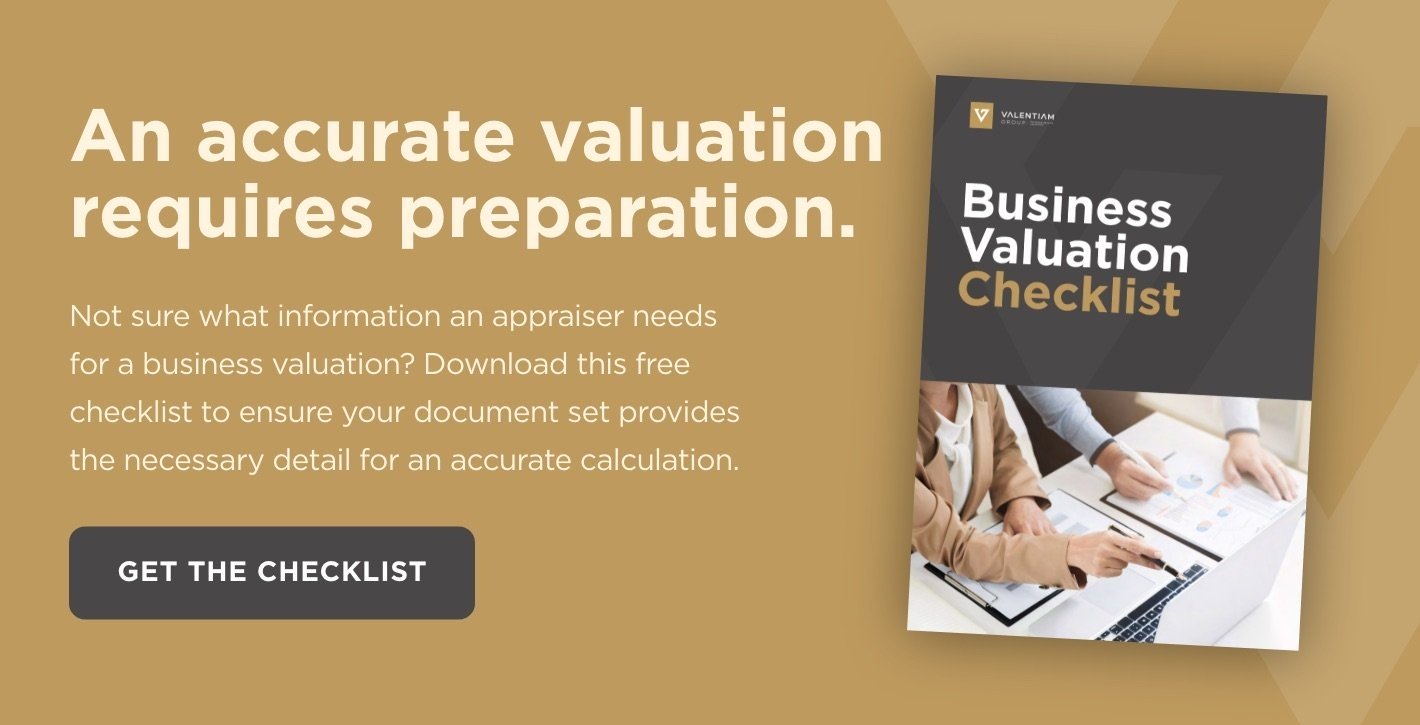Going Concern Value—What Is It?
Posted by Valentiam Group on September 10, 2020

One of the terms that is used often in valuations is going concern value. A “going concern” is a business that is currently in operation and expected to remain in operation and profitable indefinitely into the future.
An operational business is obviously more valuable than one in liquidation; intangible assets such as customer relationships, intellectual property, a trained workforce, and other assets which may have no market value in liquidation also have value, since each of these things requires time, work, and money to create. Going concern value, by definition, means that the business will continue operation with these intangible assets intact, and thus is likely to have more value than the value of its liquidated tangible assets alone.
In this article, we will examine the concept of going concern value, how going concern value relates to liquidation value and goodwill, and going concern valuation methods.
Going Concern Value Vs. Liquidation Value
Liquidation value is the value of the company’s physical or tangible assets—the amount that would be realized if, instead of continuing operations, the company was shut down and its assets were sold. Tangible assets would include real property, equipment, and inventory. These assets are typically easily valued because there are markets to establish their value. For assets where the market is limited, values can be estimated by calling auction houses, competitors, and other interested parties to figure out the sellable price of equipment and other tangible assets that the business currently owns.
The essential difference between going concern value and liquidation value is the company’s measurable intangible assets and goodwill. Measurable intangible assets might include patents and other intellectual property that may have market value but are often difficult to value. Other intangible assets might include a trained workforce, customer relationships, the established procedures for running the business, and the business’ reputation or brand. These intangible assets have no market value because they cannot typically be sold—but they do have value for a purchaser of the business, because all of these require time, effort, and money to create.
As noted in a previous article, goodwill is an intangible asset that only arises from an acquisition, when a purchaser pays a price higher than the collective tangible and measurable intangible assets to acquire a business. Goodwill is essentially compensation to the seller for the time, effort, and money invested to create a fully operational business that generates profits. The going concern value for the business will include goodwill.
Download our free Business Valuation Checklist to learn about the information needed to calculate an accurate going concern value for your business.
Going Concern Property Valuation
The three classic approaches to valuation—market, cost, and income—are the valuation methods used for going concern valuation.
1. Market Valuation MethodTwo different market approaches can be used to value a business.
The first relies on the use of EBITDA multiples. This method establishes the company’s earnings before interest, taxes, depreciation, and amortization, and then compares it to the value indicators of similar publicly-traded companies. The average EBITDA multiple for businesses in the same industry and of similar size is then applied to the Subject Company. EBITDA valuation is an imprecise way to assess value, because markets can under- or over-value companies, and it is hard to estimate the difference in multiples among similar companies due to individual company specific factors.
The second market approach is similar to the use of real estate comparables. It relies on analysis of the sales or offering prices of similar properties. Since identical transactions are unlikely to be found, value adjustments are made to account for differences between comparable properties and the Subject Company. The main drawback to this approach is that the market may not be active enough to provide sales data on comparable properties.
Due to the imprecision of both market approaches, it is used primarily as a merger and acquisition (M&A) valuation technique. In an M&A transaction, the acquiring company may anticipate a business synergy and thus is less concerned with the exact value of the Subject Company when negotiating the purchase price.
2. Cost Valuation MethodThe cost method is based on the principle of substitution. It assumes that investors will not pay more for a property than they would pay for a substitute property of equal utility. The cost approach “reproduces” the Subject Company by establishing what it would cost to reproduce it. This can be calculated as reproduction cost—the cost to rebuild the company exactly as it is—or replacement cost. Replacement cost is almost always used, because a prudent investor would not replicate a property including obsolete features. Replacement cost is then adjusted for depreciation to arrive at the value of the Subject Company.
The cost approach is a solid capital valuation method supported by current market costs and economic conditions, and provides a clear value for tangible assets. While the cost approach does not value intangible assets, it can be used in conjunction with the income approach to value these assets indirectly. The other limitation to this approach is that it requires a lot of reliable data and calculations for materials, equipment, and labor. Developing this information is time consuming and data-intensive.
3. Income Valuation MethodThe income approach assumes that a property’s present full cash value is equal to the present value of future cash flows it will provide over its remaining economic life. It is a solid approach but requires extensive detail and analysis. This valuation method has a high model risk because it relies on many assumptions but often results in a more accurate appraisal—especially when combined with other valuation methods.
In the income approach, annual cash flows are estimated over a defined forecast period and are then converted to their current value equivalents. The residual or terminal value at the end of the forecast period is then estimated and converted to its current value equivalent. The present value of the estimated cash flows and terminal value are added together to arrive at the enterprise value. Finally, working capital, intangible property, and other excluded assets are deducted to arrive at an indication of value for the tangible assets.
The income approach is a relevant approach to determine going concern value, because it provides a fair and defensible enterprise value, which is essentially the goal when attempting to establish this value. The biggest limitation of the income approach is that the value it yields is highly sensitive to assumptions about the forecast period, cost of capital, and the terminal value derived. Small changes in any of these assumptions can have a material impact on the value calculated; projections are tricky and may or may not pan out. As a result, income-based valuations are most reliable for companies with stable and predictable cash flows.
Going Concern Valuation ExampleSuppose that the liquidation value of ABC Company is calculated to be $5 million, which represents the current value of the company’s inventory, equipment, real property, and other assets that can be sold if the company is completely liquidated. This value will be less than the value of the company’s tangible assets, because often they will have to be sold at a discount—sometimes a deep discount—in order to liquidate the company. There may be few interested buyers for specialized equipment, for example, and they will take into consideration the fact that the equipment is used and will have to be moved from its current location, which may involve considerable expense. Using the income method to calculate ABC Company’s value, however, yields a going concern value of $30 million. Thanks to the company’s reputation, customer loyalty, and intellectual property in the form of patents and trademarks, the company is projected to have stable and steady cash flows, so its going concern value is much greater than its liquidation value. As the example highlights, the going concern value of a healthy, profitable company is typically many times higher than its liquidation value. As such, it is the fair and defensible value for profitable, operational businesses. |
Need help determining the going concern value of your business?
Valentiam has helped companies in a variety of industries attain accurate enterprise and asset valuations. We have extensive experience in the application of all valuation methods for a broad range of businesses and situations. Our valuation and transfer pricing specialists have worked with some of the largest companies in the world.
Contact us to see how we can help your company with your valuation and transfer pricing needs.
Topics: Business valuation
Related Posts
EBITDA Multiples By Industry: An Analysis
EBITDA multiples by industry indicate growth, profitability, and stability of profits in various sectors—and are a quick and easy way to estimate value.
Valuation Methods: A Guide
Different types of business valuation methods are suited to specific needs. Here are the three primary types of valuation techniques and when they should be used.


